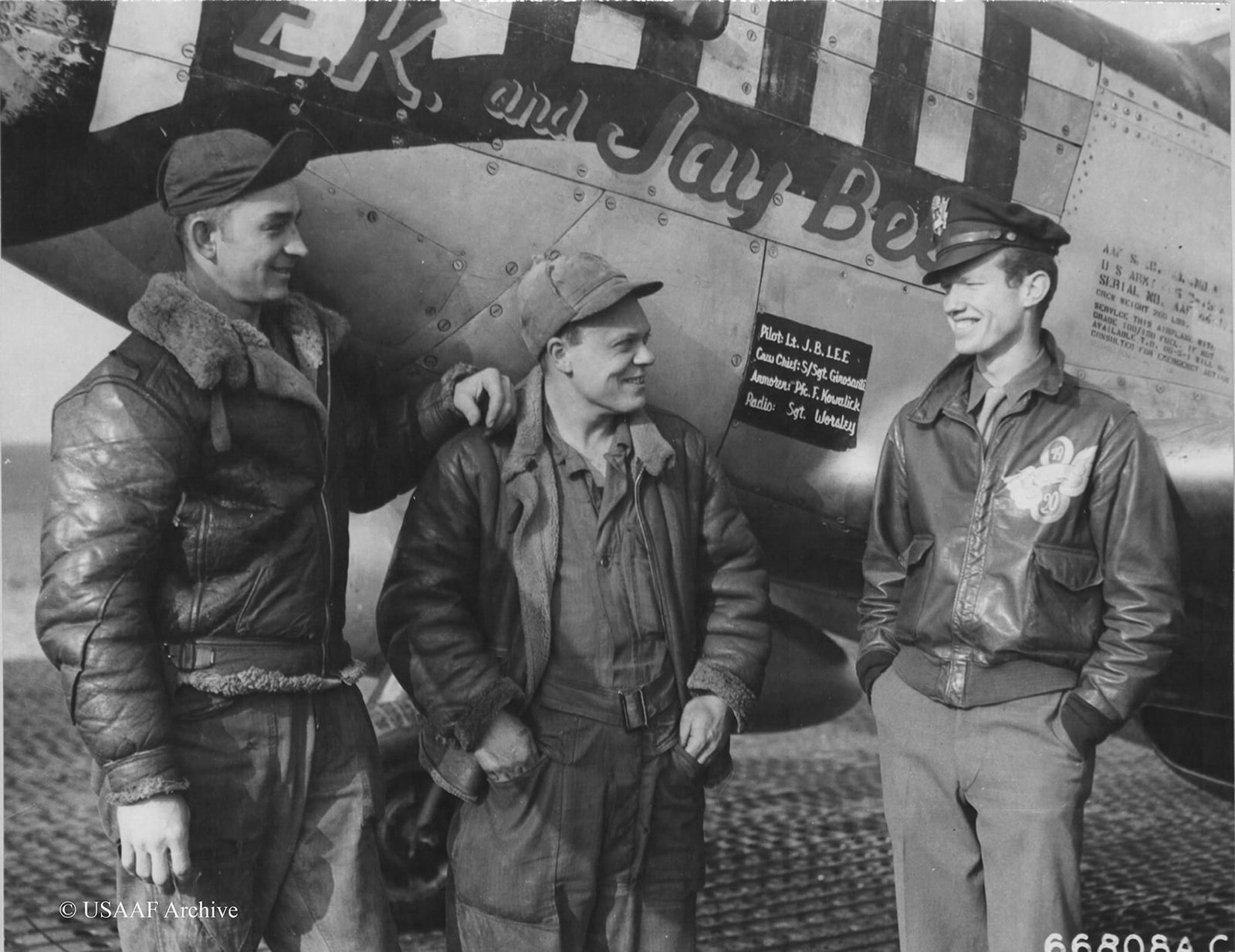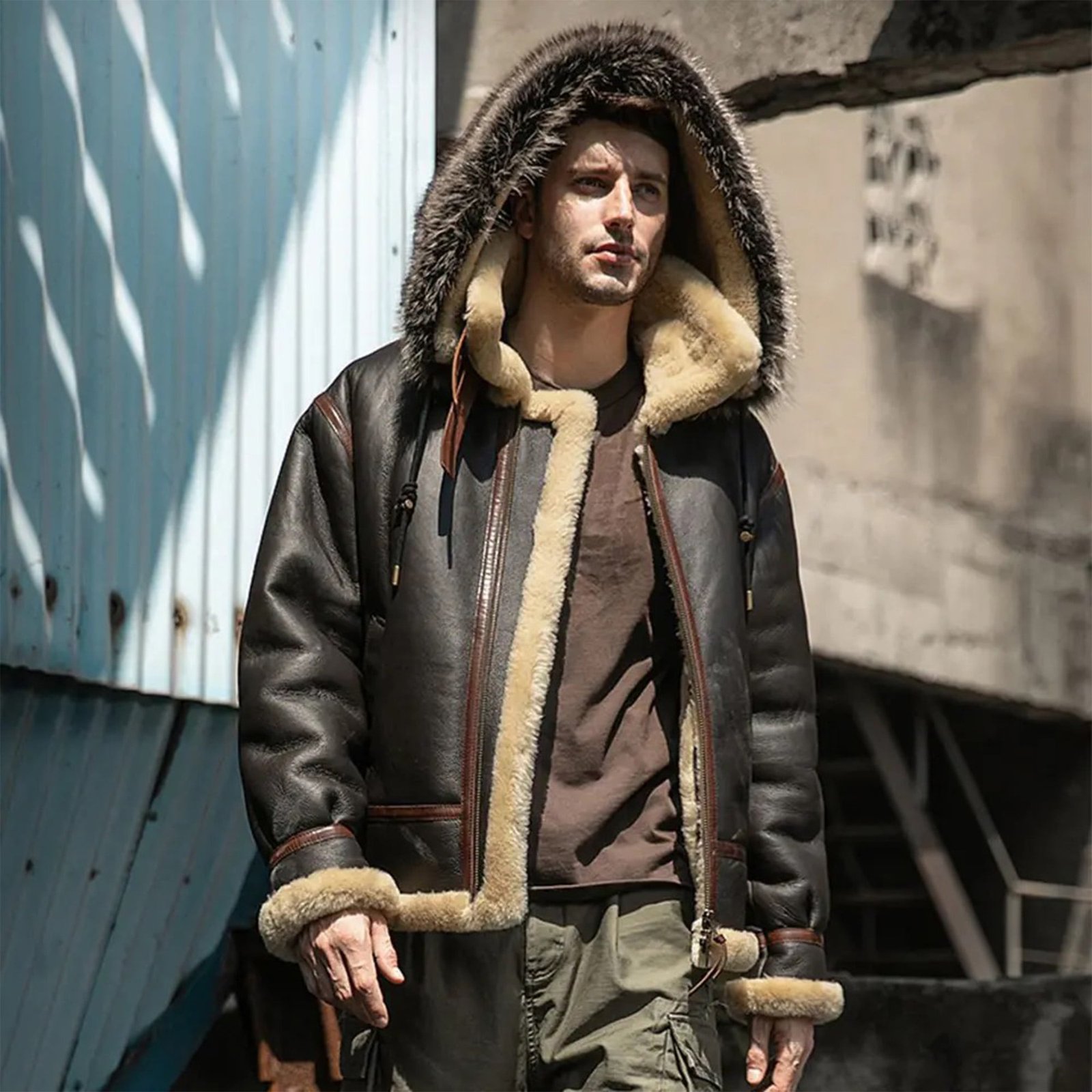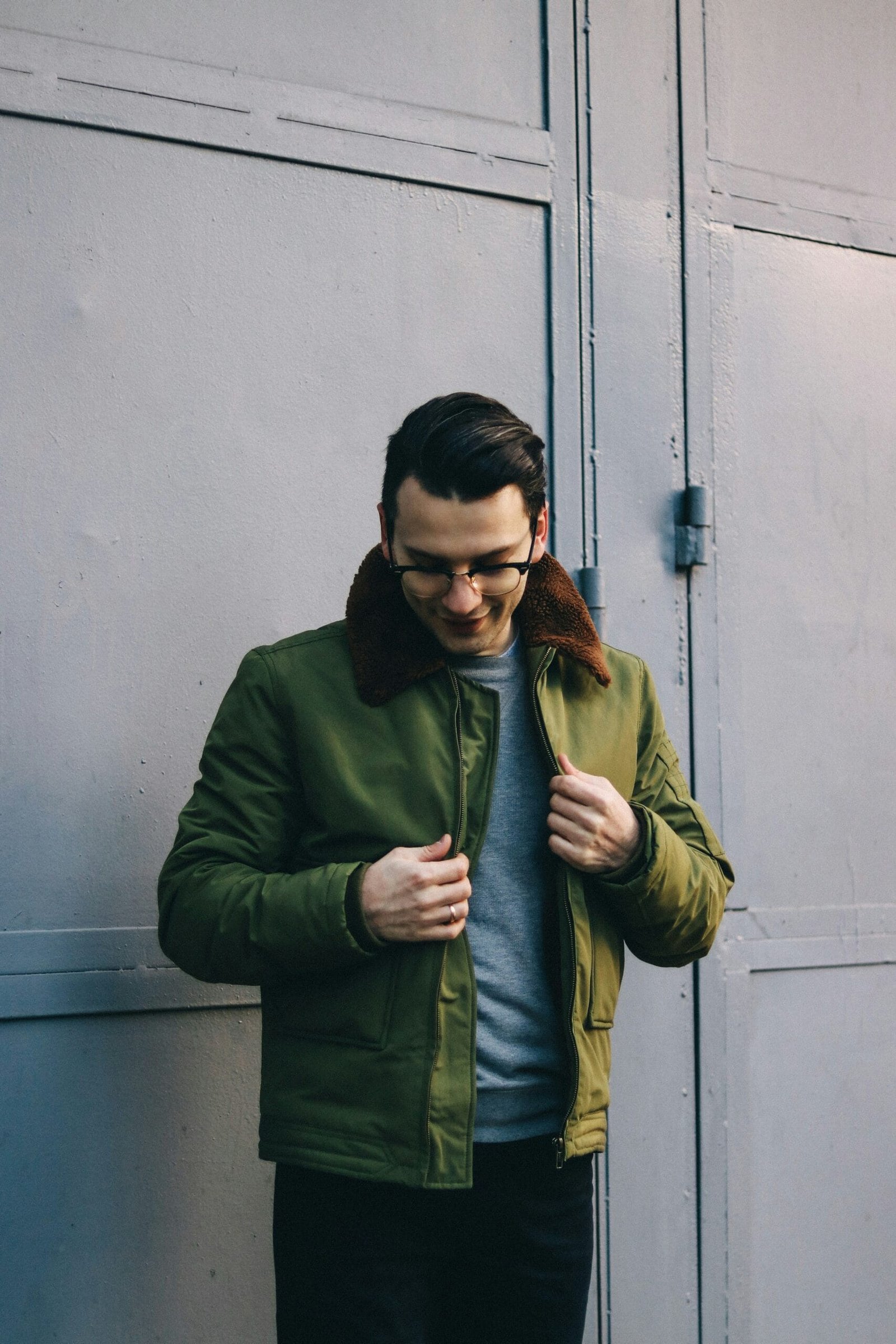The History of the B3 Bomber Jacket
Introduction to the B3 Bomber Jacket
The B3 bomber jacket stands as an enduring icon in both military and civilian fashion. Originally designed for the United States Army Air Forces during World War II, the B3 bomber jacket was engineered to withstand the extreme cold conditions faced by bomber crews at high altitudes. Made from high-quality sheepskin and lined with thick shearling, this jacket provided unparalleled warmth and comfort.
Its design was not only functional but also stylish, which contributed to its popularity beyond military use. The B3 bomber jacket soon became a symbol of ruggedness and adventure, capturing the imagination of the public and influencing fashion trends for decades to come. The utilitarian design, characterized by its oversized collar, adjustable straps, and durable materials, has been replicated and reinterpreted by various fashion brands over the years.
Beyond its practical applications, the B3 bomber jacket’s association with World War II aviation heroes added to its iconic status. Pilots and crew members who wore these jackets became synonymous with bravery and resilience. This historical significance, combined with its timeless design, ensured that the B3 bomber jacket would remain a staple in both military and civilian wardrobes.
Today, the B3 bomber jacket continues to be a sought-after piece, cherished by fashion enthusiasts and collectors alike. Its blend of functionality, history, and style has allowed it to transcend its original purpose, making it a versatile and enduring element in the world of fashion. Whether donned for its historical roots or its stylish appeal, the B3 bomber jacket remains a testament to the enduring legacy of military-inspired fashion.
The Origins of the B3 Bomber Jacket
The B3 bomber jacket has its roots firmly planted in the exigencies of World War II. Developed as a response to the specific needs of the United States Army Air Forces, this iconic garment was designed to provide essential warmth and protection for pilots enduring the harsh conditions of high-altitude missions. During this period, aircraft were not pressurized, and temperatures could plummet to dangerously low levels, often reaching -50 degrees Fahrenheit or lower.
The United States Army Air Forces collaborated with manufacturers to create a solution, resulting in the development of the B3 bomber jacket. Constructed from high-quality sheepskin, the jacket featured a shearling lining that provided exceptional thermal insulation. The sheepskin was chosen not only for its warmth but also for its lightweight properties, which were crucial for pilots who needed to maintain mobility and comfort during prolonged flights.
One of the key factors that contributed to the B3 bomber jacket’s effectiveness was its ability to retain body heat while remaining breathable. This balance was critical for pilots who faced rapid changes in temperature and pressure during their missions. The jacket’s design also took into account the practical needs of pilots, incorporating large pockets for storing essential items and reinforced seams for added durability. Over time, the B3 bomber jacket became an indispensable part of a pilot’s gear.
In essence, the B3 bomber jacket was more than just a piece of clothing; it was a vital tool that enabled pilots to perform their duties under some of the most challenging conditions imaginable. Its development marked a significant advancement in military apparel, setting a standard for future innovations in functional and protective gear.
Design and Materials
The B3 bomber jacket stands out due to its distinctive design and carefully selected materials. At the heart of its construction is a luxurious sheepskin lining, which provides exceptional insulation, making it ideal for the harsh conditions faced by bomber crews during World War II. The sheepskin’s natural properties ensure warmth, while its breathability helps to regulate body temperature, preventing overheating.
The exterior of the B3 bomber jacket is crafted from heavy-duty leather. This choice of material is not merely aesthetic but serves a functional purpose. Leather is renowned for its durability and resistance to wear and tear, which provided the necessary protection against the elements and mechanical hazards encountered during flight operations. Its robust nature ensured that the jacket could withstand the rigors of military use, providing long-lasting service.
A defining feature of the B3 bomber jacket is its fur collar. This element was not just for style but served a critical function. The fur collar offered additional warmth around the neck area, a vulnerable spot during cold flights at high altitudes. The collar could be turned up and fastened to shield the wearer from biting winds and freezing temperatures.
Another characteristic design element is the inclusion of buckled straps. These straps are strategically placed at the neck and waist, allowing the wearer to secure the jacket tightly, thus minimizing the entry of cold air. This adjustable feature enhanced the jacket’s ability to retain heat and offered a personalized fit for comfort and functionality.
The combination of sheepskin, heavy-duty leather, fur, and buckled straps made the B3 bomber jacket not only a protective garment but also a symbol of resilience and ingenuity. Its design and materials were meticulously chosen to meet the demands of military aviation, ensuring that it remained a reliable piece of equipment for those who relied on it in extreme conditions.
The Evolution of the B3 Bomber Jacket During WWII
The B3 bomber jacket underwent significant evolution during World War II, driven by the need to enhance its functionality and comfort for pilots operating in extreme conditions. Initially designed in 1934, the B3 bomber jacket was primarily crafted from sheepskin with a shearling lining, making it exceptionally warm. However, as the war progressed, the demands of aerial combat and the harsh environments in which pilots flew necessitated several modifications.
One of the primary changes was the introduction of reinforced leather patches on the sleeves and shoulders to provide additional durability in high-wear areas. This modification was crucial as pilots often had to maneuver in cramped cockpit spaces, which caused significant wear and tear on their uniforms. Moreover, the original design’s heavy weight posed a challenge for pilots, leading to the development of lighter versions that retained the essential warmth without the added bulk.
Another notable evolution was the inclusion of more robust zippers and fastenings. Early versions of the B3 bomber jacket had basic closures that sometimes failed under the stress of high-altitude flights. Improved zippers and buckles were introduced to ensure that the jacket could be securely fastened, providing better insulation against the cold. Additionally, adjustable waistbands and cuffs were incorporated to allow pilots to customize the fit, thereby enhancing comfort during long missions.
Throughout WWII, various manufacturers produced different versions of the B3 bomber jacket, each with subtle variations. These iterations included adjustments in the cut of the jacket, the types of leather used, and even the lining materials. Some versions featured additional pockets for practicality, while others experimented with different collar designs to improve neck protection from the cold wind.
In essence, the B3 bomber jacket’s evolution during World War II was marked by continuous improvements aimed at optimizing its performance and comfort. These modifications ensured that pilots could rely on their gear, even in the most challenging conditions, solidifying the B3 bomber jacket’s place as an iconic piece of military history.
Post-War Popularity and Cultural Impact
The B3 bomber jacket, originally designed for military use during World War II, experienced a significant transition to civilian fashion in the post-war era. This shift was largely influenced by the jacket’s rugged aesthetic and practical design, which resonated with the public’s fascination with military apparel. As veterans returned home, they often brought their service jackets with them, introducing these garments into everyday life. The B3 bomber jacket quickly became a symbol of resilience and adventure, capturing the imagination of a society eager to move forward while honoring the past.
The 1950s and 1960s saw the B3 bomber jacket being adopted by various subcultures. In particular, it became a staple of the burgeoning motorcycle community. Riders were drawn to the jacket’s warmth and durability, essential for long rides in varying weather conditions. The association with the rebellious spirit of the motorcycle culture only amplified the B3’s appeal, solidifying its status as an icon of nonconformity and freedom.
Popular media further cemented the B3 bomber jacket’s place in cultural history. Films like “Top Gun” and “The Right Stuff” showcased the jacket as a symbol of bravery and rugged masculinity. These cinematic representations contributed to the jacket’s mystique and desirability. Music also played a role, with rock and punk musicians donning the B3 bomber jacket as part of their signature looks. This connection to influential figures in entertainment reinforced the jacket’s image as a garment that conveys strength and individualism.
Throughout the decades, the B3 bomber jacket has maintained its allure, continuously being reinterpreted by fashion designers and embraced by new generations. Its enduring popularity speaks to its versatile nature and the powerful symbolism it carries. Whether worn for its functionality or its iconic status, the B3 bomber jacket remains a timeless piece that encapsulates a spirit of adventure and resilience.
Modern Reinterpretations and Fashion Trends
In recent years, the B3 bomber jacket has witnessed a remarkable resurgence in the fashion world, reimagined by contemporary designers for a modern audience. This classic piece, originally designed for functionality and warmth during World War II, has been thoughtfully retained and modified to align with today’s style sensibilities.
One of the key features that have been preserved in modern reinterpretations is the jacket’s iconic shearling lining. This element not only continues to provide the essential insulation but also adds a luxurious touch, making the B3 bomber jacket a fashionable choice for both men and women. The rugged leather exterior, another hallmark of the original design, has also been maintained, though often updated with more refined finishes and a variety of colors to cater to diverse tastes.
Contemporary designers have introduced several modifications to enhance the jacket’s appeal. Slimmer cuts and tailored fits have replaced the bulkier silhouettes of the past, making the B3 bomber jacket more versatile and suitable for everyday wear. Additionally, modern versions often feature functional updates such as zippered pockets, detachable hoods, and adjustable waistbands, blending style with practicality.
The influence of the B3 bomber jacket can be seen across various fashion trends. It has become a staple in streetwear, where its rugged aesthetic complements the casual, edgy vibe of the genre. High-end fashion brands, such as Burberry and Balenciaga, have incorporated the B3 bomber jacket into their collections, showcasing its versatility and timeless appeal. Notable designers like Alexander Wang and Rick Owens have also embraced the B3 style, integrating it into their avant-garde and minimalist designs.
The B3 bomber jacket’s enduring legacy and modern reinterpretations demonstrate its unique ability to transcend time and trends, solidifying its place as a quintessential piece in contemporary fashion.
The B3 Bomber Jacket in Popular Media
The B3 bomber jacket has made numerous notable appearances in popular media, significantly influencing its public perception and enduring popularity. One of its most iconic portrayals is in the film “Top Gun,” where Tom Cruise’s character, Maverick, sports a variant of the B3 jacket. This appearance not only elevated the jacket’s status in fashion but also cemented its association with daring and adventurous personas.
Television has also played a substantial role in popularizing the B3 bomber jacket. For instance, the jacket appeared in the series “Stranger Things,” worn by the character Hopper. This portrayal highlighted the jacket’s rugged and practical appeal, aligning it with the show’s 1980s nostalgia and adventure themes. As a result, the B3 bomber jacket saw a resurgence in mainstream fashion, embraced by both fashion enthusiasts and casual wearers alike.
Beyond films and television, the B3 bomber jacket has been a favorite among celebrities and musicians, further amplifying its cultural impact. Famous personalities such as Kanye West and David Beckham have been seen wearing the jacket, showcasing its versatility and timeless appeal. These endorsements by high-profile figures have contributed to the jacket becoming a staple in modern wardrobes, transcending its military origins to become a symbol of style and resilience.
Moreover, the B3 bomber jacket’s presence in video games such as “Call of Duty” has introduced it to younger audiences, ensuring its relevance across generations. The jacket’s rugged aesthetic and historical significance resonate well within the gaming community, fostering a sense of authenticity and historical appreciation.
In conclusion, the B3 bomber jacket’s appearances in movies, television shows, and other forms of popular media have significantly shaped its public perception. Iconic characters and celebrities have contributed to its lasting popularity, making it a timeless piece that continues to captivate fashion enthusiasts around the world.
Conclusion: The Legacy of the B3 Bomber Jacket
The B3 bomber jacket has undergone a remarkable transformation from its humble beginnings as a military necessity to its current status as a fashion icon. Originally designed for aviators during World War II, the B3 bomber jacket was engineered to provide essential warmth and protection at high altitudes. Its robust construction, featuring shearling lining and durable leather, made it an indispensable piece of gear for pilots facing the harsh conditions of aerial combat.
As the years have passed, the B3 bomber jacket has transcended its military origins to become a timeless fashion staple. Its rugged yet sophisticated design has captivated the imaginations of fashion enthusiasts and designers alike. The jacket’s distinctive look, characterized by its shearling collar and rugged exterior, has been embraced by multiple generations, making it a versatile addition to wardrobes around the world.
Moreover, the B3 bomber jacket’s enduring appeal lies in its ability to blend functionality with style. While it continues to serve as a practical piece of outerwear, its aesthetic qualities have ensured its place in contemporary fashion. The jacket has been reinterpreted and reinvented by designers, appearing in various forms on runways and in streetwear collections. This adaptability highlights the B3 bomber jacket’s unique ability to remain relevant across different fashion eras and trends.
The legacy of the B3 bomber jacket is a testament to its universal appeal and lasting impact. It stands as a symbol of resilience and innovation, reflecting the ingenuity of its original design and the creativity of those who have reimagined it. As both a historical artifact and a modern fashion statement, the B3 bomber jacket continues to capture the essence of timeless style and enduring functionality.



















